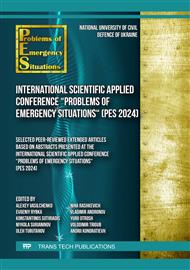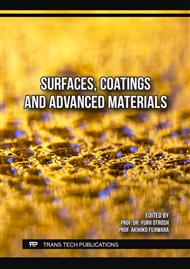[1]
O. Rybalova, M. Malovanyy, O. Bondarenko, О. Proskurnin, K. Belokon, H. Korobkova, Method of Assessing the Potential Risk to the Health of the Population During Recreational Water Withdrawal, Journal of Ecological Engineering. 23/5 (2022) 81–91
DOI: 10.12911/22998993/146998
Google Scholar
[2]
M. Vasiliev, I. Movchan, O. Koval, Diminishing of ecological risk via optimization of fire-extinguishing system projects in timber-yards. Naukovyi Visnyk Natsionalnoho Hirnychoho Universytetu. 5 (2001) 106–113.
Google Scholar
[3]
B. Pospelov, V. Andronov, E. Rybka, O. Krainiukov, K. Karpets, O. Pirohov, I. Semenyshyna, R. Kapitan, A. Promska, O. Horbov, Development of the correlation method for operative detection of recurrent states. Eastern-European Journal of Enterprise Technologies. 6/4 (102) (2019) 39–46
DOI: 10.15587/1729-4061.2019.187252
Google Scholar
[4]
B. Pospelov, E. Rybka, R. Meleshchenko, O. Krainiukov, S. Harbuz, Y. Bezuhla, I. Morozov, A. Kuruch, O. Saliyenko, R. Vasylchenko, Use of uncertainty function for identification of hazardous states of atmospheric pollution vector. Eastern-European Journal of Enterprise Technologies. 2/10 (2020) 6–12
DOI: 10.15587/1729-4061.2020.200140
Google Scholar
[5]
O. Popov, D. Taraduda, V. Sobyna, D. Sokolov, M. Dement, A. Pomaza-Ponomarenko, Emergencies at Potentially Dangerous Objects Causing Atmosphere Pollution: Peculiarities of Chemically Hazardous Substances Migration. Studies in Systems, Decision and Control. 298 (2020) 151–163
DOI: 10.1007/978-3-030-48583-2_10
Google Scholar
[6]
B. Pospelov, V. Kovrehin, E. Rybka, O. Krainiukov, O. Petukhova, T. Butenko, P. Borodych, I. Morozov, O. Horbov, I Hrachova, Development of a method for detecting dangerous states of polluted atmospheric air based on the current recurrence of the combined risk. Eastern-European Journal of Enterprise Technologies, 5/9 (107) (2020) 49–56
DOI: 10.15587/1729-4061.2020.213892
Google Scholar
[7]
A. Vasyukov, V. Loboichenko, S. Bushtec, Identification of bottled natural waters by using direct conductometry. Ecology, Environment and Conservation. 22/3 (2016) 1171–1176.
Google Scholar
[8]
S. Vambol, V. Vambol, O. Kondratenko, V. Koloskov, Y. Suchikova, Substantiation of expedience of application of high-temperature utilization of used tires for liquefied methane production. Journal of Achievements in Materials and Manufacturing Engineering. 87/2 (2018) 77–84
DOI: 10.5604/01.3001.0012.2830
Google Scholar
[9]
V. Andronov, B. Pospelov, E. Rybka, Increase of accuracy of definition of temperature by sensors of fire alarms in real conditions of fire on objects. Eastern-European Journal of Enterprise Technologies. 4/5 (82) (2016) 38–44
DOI: 10.15587/1729-4061.2016.75063
Google Scholar
[10]
M. Kustov, E. Slepuzhnikov, V. Lipovoy, I. Khmyrov, D. Firdovsi, O. Buskin, Procedure for implementation of the method of artificial deposition of radioactive substances from the atmosphere. Nuclear and Radiation Safety, 3/83 (2019) 13–25
DOI: 10.32918/nrs.2019.3(83).02
Google Scholar
[11]
B. Pospelov, A. Andronov, E. Rybka, S. Skliarov, Research into dynamics of setting the threshold and a probability of ignition detection by selfadjusting fire detectors. Eastern-European Journal of Enterprise Technologies. 5/9 (89) (2017) 43–48
DOI: 10.15587/1729-4061.2017.110092
Google Scholar
[12]
V. Loboichenko, A. Vasyukov, T. Tishakova, Investigations of Mineralization of Water Bodies on the Example of River Waters of Ukraine. Asian Journal of Water, Environment and Pollution. 14/4 (2017) 37–41
DOI: 10.3233/AJW-170035
Google Scholar
[13]
S. Ragimov, V. Sobyna, S. Vambol, V. Vambol, A. Feshchenko, A. Zakora, E. Strejekurov, V. Shalomov, Physical modelling of changes in the energy impact on a worker taking into account high-temperature radiation. Journal of Achievements in Materials and Manufacturing Engineering. 91/1 (2018) 27–33
DOI: 10.5604/01.3001.0012.9654
Google Scholar
[14]
M. Kryshtanovych, L. Antonova, V. Filippova, S. Dombrovska, T. Pidlisna, Influence of COVID-19 on the Functional Device of State Governance of Economic Growth of Countries in the Context of Ensuring Security International Journal of Safety and Security Engineering. 12/2 (2022) 193–199
DOI: 10.18280/ijsse.120207
Google Scholar
[15]
World Health Statistics 2023: Monitoring Health for the SDGs. World Health Organization 2023 https://www.who.int/data/gho/publications/world-health-statistics.
Google Scholar
[16]
H.R. Saberi, H. Rabiei, A. Zare, M.D. Jazari, M. Malakoutikhah, Analysis of the research subjects and hot topics of occupational diseases through the Web of Science from 1975 to 2021. Frontiers in Public Health. 10 (2022) 1009203
DOI: 10.3389/fpubh.2022.1009203
Google Scholar
[17]
S. Ullah, A. Ullah, J. Lee, Y. Jeong, M. Hashmi, C. Zhu, K.I. Joo, H.J. Cha, I.S. Kim, Reusability Comparison of Melt-Blown vs Nanofiber Face Mask Filters for Use in the Coronavirus Pandemic. ACS Applied Nano Materials. 3(7) (2020) 7231–7241
DOI: 10.1021/acsanm.0c01562
Google Scholar
[18]
A.B. Wang, X. Zhang, L.J. Gao, T. Zhang, H.J. Xu, Y.J. Bi, A Review of Filtration Performance of Protective Masks. International Journal of Environmental Research and Public Health. 28 20(3) (2023) 2346
DOI: 10.3390/ijerph20032346
Google Scholar
[19]
H. Arouni, U. Farooq, P. Goswami, N. Kapur, S.J. Russell, Coalescence efficiency of surface modified PBT meltblown nonwovens in the separation of water from diesel fuel containing surfactants. Results in Engineering, 4 (2019) 100048. https://doi.org/10.1016/j.rineng. 2019.10008
DOI: 10.1016/j.rineng.2019.100048
Google Scholar
[20]
S. Baek, S. Kim, Y. Yoon, K.S. Kim, J. Bae, Development of an Air Filter to Remove Fine Dust from Indoor Air Using a Traditional Korean Paper, 'Hanji'. Sustainability. 16(1) (2024) 179
DOI: 10.3390/su16010179
Google Scholar
[21]
Z. Shao, H. Chen, Q. Wang, G. Kang, X. Wang, W. Li, Y. Liu, G. Zheng, High-performance multifunctional electrospun fibrous air filter for personal protection: A review. Separation and Purification Technology. 1(302) (2022) 122175
DOI: 10.1016/j.seppur.2022.122175
Google Scholar
[22]
E.S. Jang, C.W. Kang, H.Y. Kang, S.S. Jang, Sound Absorption Property of Traditional Korean Natural Wallpaper (Hanji). Journal of the Korean Wood Science and Technology. 46(6) (2018) 703–712
DOI: 10.5658/WOOD.2018.46.6.703
Google Scholar
[23]
M. Al-Amin, M.T. Hossain, M. Tahir, D. Wyman, S.M.F. Kabir, A Critical Review on Reusable Face Coverings: Mechanism, Development, Factors, and Challenges. Textiles. 3(1) (2023) 142–162
DOI: 10.3390/textiles3010011
Google Scholar
[24]
J. Mańkowski, M. Zimniewska, W. Gieparda, B. Romanowska, A. Kicińska-Jakubowska, J. Kołodziej, J. Foksowicz-Flaczyk, S. Rojewski, K. Bujnowicz, P. Przybylska, E. Kwiatkowska, Md. Masud Alam, W. Rózanska, Al. Wawro, E. Hołderna-Kedzia, Development of a Layer Made of Natural Fibers to Improve the Ecological Performance of the Face Mask Type II. Materials 16(16) (2023) 5668
DOI: 10.3390/ma16165668
Google Scholar
[25]
D. Battegazzore, F. Cravero, G. Bernagozzi, A. Frache, Designing a 3D printable polypropylene-based material from after use recycled disposable masks. Materials Today Communications. 32 (2022) 103997
DOI: 10.1016/j.mtcomm.2022.103997
Google Scholar
[26]
E.A. Ogbuoji, A.M. Zaky, I.C. Escobar, Advanced Research and Development of Face Masks and Respirators Pre and Post the Coronavirus Disease 2019 (COVID-19) Pandemic: A Critical Review. Polymers. 13(12) (2021) 1998
DOI: 10.3390/polym13121998
Google Scholar
[27]
A. Pogačnik Krajnc, L. Pirker, U. Gradišar Centa, A. Gradišek, I.B. Mekjavic, M. Godnič, M. Čebašek, T. Bregant, M. Remškar, Size- and Time-Dependent Particle Removal Efficiency of Face Masks and Improvised Respiratory Protection Equipment Used during the COVID-19 Pandemic. Sensors (Basel). 24 21(5) (2021) 1567
DOI: 10.3390/s21051567
Google Scholar
[28]
O. Bazaluk, A. Ennan, S. Cheberiachko, O. Deryugin, Y. Cheberiachko, P. Saik, V. Lozynskyi, I. Knysh, Research on Regularities of Cyclic Air Motion through a Respirator Filter. Applied Sciences. 11 (2021) 3157
DOI: 10.3390/app11073157
Google Scholar
[29]
T. Höhnemann, J. Schnebele, W. Arne, I. Windschiegl, Nanoval Technology-An Intermediate Process between Meltblown and Spunbond. Materials. 16(7) (2023) 2932
DOI: 10.3390/ma16072932
Google Scholar
[30]
P. Pratumpong, T. Cholprecha, N. Roungpaisan, N. Srisawat, S. Toommee, C. Pechyen, Y. Parcharoen, Effects of Melt-Blown Processing Conditions on Nonwoven Polylactic Acid and Polybutylene Succinate. Polymers. 15(20) (2023) 4189 https://doi.org/10.3390/ polym15204189
DOI: 10.3390/polym15204189
Google Scholar
[31]
O. Bazaluk, S. Cheberiachko, Y. Cheberiachko, O. Deryugin, V. Lozynskyi, I. Knysh, P. Saik, M. Naumov, Development of a Dust Respirator by Improving the Half Mask Frame Design. International Journal of Environmental Research and Public Health. 20 18(10) (2021) 5482
DOI: 10.3390/ijerph18105482
Google Scholar
[32]
I.A. Lyashenko, T.H. Pham, V.L. Popov, Pull-Off Strength and Mechanical Energy Dissipation in Adhesive Contacts: Experiments and Simulations. Coatings. 14 (2) (2024) 188
DOI: 10.3390/coatings14020188
Google Scholar
[33]
E. Panina, R. Mardanov, S. Zaripov, Mathematical Model of the Flow in a Nanofiber/ Microfiber Mixed Aerosol Filter. Mathematics. 11 (16) (2023) 3465 https://doi.org/10.3390/ math11163465
DOI: 10.3390/math11163465
Google Scholar
[34]
L. Pisanu, L.C. Santiago, J.D.V. Barbosa, V.E. Beal, M.L.F. Nascimento, Effect of the Process Parameters on the Adhesive Strength of Dissimilar Polymers Obtained by Multicomponent Injection Molding. Polymers. 13 (7) (2021) 1039
DOI: 10.3390/polym13071039
Google Scholar
[35]
S. Cheberyachko, Y. Cheberyachko, M. Naumov, O. Deryugin, Development of an algorithm for effective design of respirator half-masks and encapsulated particle filters. International Journal of Occupational Safety and Ergonomics. 28 (2) (2022) 1145–1159
DOI: 10.1080/10803548.2020.1869429
Google Scholar
[36]
S. Cheberiachko, I. Knysh, D. Pustovoi, O. Sharovatova, Research of operational properties of household fabrics for production of protective masks. Materials Science Forum. 1038 (2021) 221–232
DOI: 10.4028/www.scientific.net/MSF.1038.221
Google Scholar
[37]
P. Kovács, B. Körömi, Z. Weltsch, M. Berczeli, Investigation of the Tensile Strength of Adhesive-Bonded Steels Using Surface Treatments. Materials. 16 (24) (2023) 7663
DOI: 10.3390/ma16247663
Google Scholar



